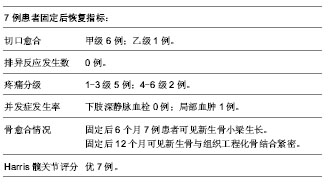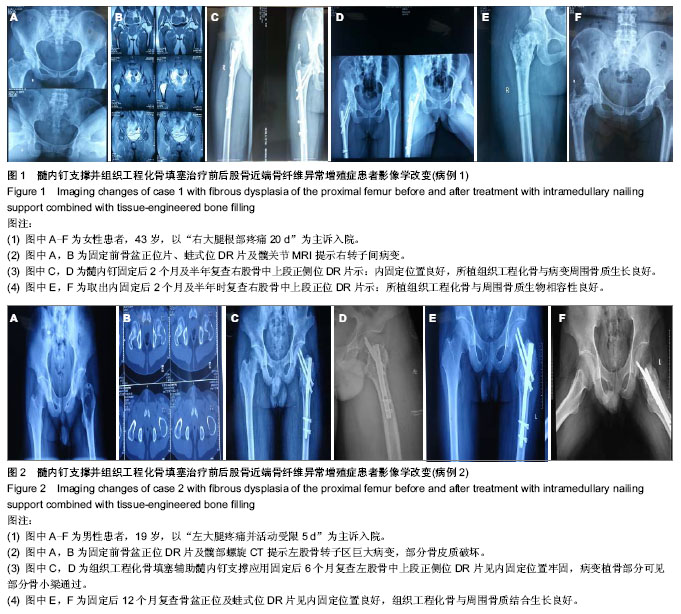| [1] Stanton RP. Surgery for fibrous dysplasia. J Bone Miner Res. 2006;21(Suppl 2):P105-109. [2] Stanton RP, Ippolito E, Springfield D, et al. The surgical management of fibrous dysplasia of bone. Orphanet J Rare Dis. 2012;7(Suppl 1):S1. [3] Bresler F, Simon P, Schmitt D, et al. Digital image analysis of bone allograft union in sheep. Acta Orthop Scand. 1998,69(2): 181-183.[4] 刘玮,胡蕴玉,陆裕朴,等.重组合异种骨的研制及其生物活性分析[J].第四军医大学学报, 1991,71(7):378-380.[5] Guille JT, Kumar SJ, MacEwen GD. Fibrous dysplasia of the proximal part of the femur. Long-term results of curettage and bone-grafting and mechanical realignment. J Bone Joint Surg (Am). 1998;80(5):648-658. [6] 同志超,王坤正,焦宁,等.股骨近端纤维结构不良的固定治疗[J].中国骨伤,2011,24(4):345-348. [7] 张同韩,廖贵清.骨纤维异常增殖症的研究进展[J].中华口腔医学研究杂志(电子版),2008;2(5):531.[8] Di Caprio MR, Enneking WF. Fibrous dysplasia. Pathophysiology, evaluation and treatment. J Bone Joint Surg Am. 2005;87(8):1848-1864.[9] 崔岩,刘建国,李叔强,等.骨纤维结构不良的诊断和治疗进展[J].中国组织工程研究与临床康复,2007,11(10):1905.[10] 牛晓辉,王臻,黄耀添,等.98例四肢骨纤维结构不良临床分析[J].中国矫形外科杂志,1998,5(4):329.[11] 石伟,苗旭漫,刘绍臣,等.经皮股骨近端交锁髓内针内固定治疗老年股骨转子间骨折(附180例报道)[J].中国矫形外科杂志,2010, 18(2):100.[12] 于小奎,朱兵,孙天胜,等.股骨近端骨纤维结构不良伴髋内翻畸形的髓内固定疗效[J].中国组织工程研究与临床康复,2013,17(26): 4804-4811.[13] 胥少汀,张龙海,朱兵,等.肋骨移植治疗长骨纤维异样增殖症[J].中华外科杂志,2002,40(7):555.[14] 祝联,邹成,朱敏,等.组织工程化骨修复四肢骨缺损的初步临床研究[J].组织工程与重建外科杂志,2009,5(3):121-124.[15] Kelly MH, Brillante B, Collins MT. Pain in fibrous dysplasia of bone: age-related changes and the anatomical distribution of skeletal lesions. Osteoporos Int. 2008;19(1):57-63. [16] Li GD, Ogose A, Hotta T, et al. Long-term efficacy of oral alendronate therapy in an elderly patient with polyostotic fibrous dysplasia: a case report. Oncol Lett. 2011;2(6): 1239-1242. [17] Chapurlat RD, Hugueny P, Delmas PD, et al. Treatment of fibrous dysplasia of bone with intravenous pamidronate: long-term effectiveness and evaluation of predictors of response to treatment. Bone. 2004;35(1):235-242.[18] State Council of the People's Republic of China. Administrative Regulations on Medical Institution. 1994-09-01.[19] 邱贵兴,戴克戎.骨科手术学[M].3版.北京:人民卫生出版社,2005.[20] 中华医学会.临床诊疗指南:骨科分册[M].北京:人民卫生出版社, 2009.[21] 王鹏建,李海峰,阮狄克,等.股骨粗隆间骨折内固定术后并发症原因分析[J].中国骨与关节损伤杂志,2010,25(1):27.[22] Stanton RP, Diamond L. Surgical management of fibrous dysplasia in McCune-Albright syndrome. Pediatr Endocrinol Rev. 2007;4(Suppl 4):446-452.[23] 许多富,邓珩,王礼.小儿骨纤维结构不良治疗体会[J].吉林医学,2011,32(6):1164.[24] 袁忠治,汤晨逢,李国新,等.植骨内固定治疗成人股骨近端纤维结构不良13例[J].中国组织工程研究与临床康复,2009, 13(30): 5985-5990. [25] 傅磊,贾俊峰,崔晓虎.交锁髓内针加自体骨移植治疗股骨骨纤维结构不良27例[J].临床和实验医学杂志,2010,9(24):1878-1879.[26] 邹沙沙,陈婷婷,田汝辉,等.自体髂骨植骨供骨区并发症的Meta分析[J].中国组织工程研究,2013,17(5):931-937.[27] 孙磊,孟国林,陈磊,等.以海藻酸盐及异种骨复合技术制备组织工程化骨及体内成骨[J].中国组织工程研究与临床康复,2010, 14(8): 1508-1512.[28] 张龙海,胥少汀,朱兵,等.四肢骨纤维异样增殖症的手术治疗[J].中国矫形外科杂志,2002,10(11):1054-1056. [29] 海国栋,郭卫,姬涛,等.股骨近端骨纤维结构不良的外科治疗-一种分区方法[J].中国矫形外科杂志,2010,18(1):26-29. [30] 朱敏,凡道斌,王欣,等.股骨近端骨的纤维结构不良伴严重弯曲畸形的治疗方法探讨[J].中国骨肿瘤骨病,2006,5(5):293-295. |


.jpg)